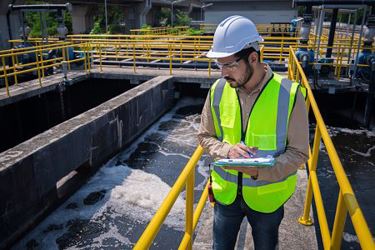General Considerations For Treating Water For Difficult Pollutants
By Dr. J.H. Wakefield

As a matter of course, we normally consider removing various pollutants by direct means such as microbial degradation, chemical treatment that results in a change in the pollutant in some way that is to our benefit (usually oxidation/ reduction), or in some manner that results in products easily removed such as gases, various precipitants, or even degraded compounds that are no longer toxic. Some methods are entirely physical, such as centrifugation and filtration, even settling; others are semi-hybrid measures, such as exploitation of various adsorption criteria that do not require chemical change.
As scientists and engineers, we depend heavily on education, experience, and precedence. Every once in a while, we do everything correctly (or at least logically) and events evolve into a situation that is uncontrollable. Such a situation arose in West Texas that resulted in the formation of the “West Texas Dead Sea” — aka Lake Boehmer (Böhmer) — which inspired this article. In this particular case, we encountered extremely concentrated brines that are generating copious amounts of hydrogen sulfide (H2S) at a highly toxic level. Where to go? Our general considerations need to be addressed firstly; but, after we exhaust them, we must move on. General considerations are listed in the following.
Some pollutants must be considered separately that present some problem or other in seemingly inexhaustible quantities, such as toxic metallic ions, radioactive isotopes of various kinds and hazard levels, and especially defined compounds that are virtually completely refractory to either chemical or microbial degradation. Such compounds are now arising as per- and polyfluoroalkyl substances (PFAS) — virtual “forever chemicals” until we can design a method for their removal from waste streams.
Metallic ions are, by far, the easiest of these pollutants to remove. All that is required is to find an acceptable adsorbent so that the adsorbent/metallic ion complex is non-toxic and is removable from the wastestream. Examples include ferric hydroxide (the hydroxylated form of Fe2O3), which is effective in the adsorption of the various oxyanions of arsenic (As); and calcium sulfate (CaSO4), which behaves similarly in the adsorption of selenium (Se) oxyanions. Note that many of these adsorbents of an ion-exchange nature are cationic exchangers, which is why these oxyanions are so hard to remove.
Radioisotope removal is a step up in difficulty and the number of variables that must be addressed. One needs to know the intensity of radiation encountered, the specific nature of the radiation, the various fluid dynamics involved in processing the wastestream, the sequestration of the radiation by a specific adsorbent, how this complex is to be stored after the radioisotope(s) have been sequestered, and many other parameters that one must address to satisfy the military and civilian authorities. Of overriding concern is to avoid treatment of any fissionable radioisotopes.
The remaining nightmare of removal involves the “eternal chemicals”, the PFAS that are quite difficult to remove because of several issues: variable definition of the actual compounds involved and their characterization (that is, straight-chain, branched, or substituted, or various combinations thereof); their refractory nature to chemical and microbial treatment; the difficulty of actually testing the efficacy of any treatment in the subsequent wastestream after removal of the PFAS; the current ineffective methods that are either available or proposed; and, finally, the nature of regulatory requirements (which are also a current nightmare).
We may have finally arrived at a situation where the best solution is one of physical removal in regard to these PFAS without involving any chemical or structural properties of the PFAS. We await only a meaningful assay that will enable us to issue a proof-of-claims of any treatment that proposes a solution to this problem. That is to say, the only way we can solve or remediate a problem is have a peer-reviewed method that can provide a statistically significant method where we are able to truly evaluate before-and-after conditions of whatever our solution to the problem is.
Dr. J.H. Wakefield is a consulting scientist/engineer with more than 30 years of experience in water/wastewater treatment. He holds advanced degrees in microbiology and physical/analytical chemistry and has been a practicing chemical and environmental engineer for many years.
